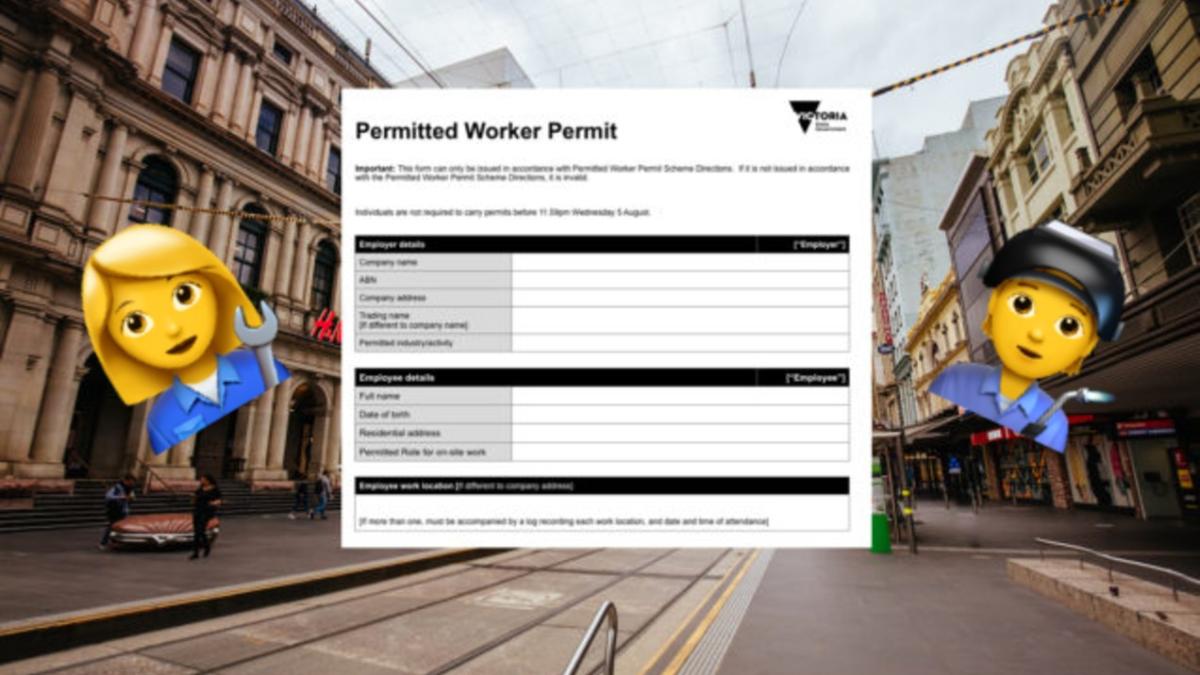
Melbourne’s Stage 4 coronavirus restrictions have kicked in, forcing countless retailers, manufacturers, and office-based workplaces to close their doors.
It sucks – but things are changing for the employees who are still allowed to work on-site, too.
From 11:59pm tonight, every Melbourne resident who leaves their home for work will need to carry a special worker permit.
Here’s what you need to know about the incoming permit system.
What’s the go?
Under Stage 4 lockdowns, there are very few lawful reasons to be outside.
Victoria Police will be running compliance checks to make sure Melbourne residents are following the restrictions, and big fines are on the cards for people who break the rules.
That brings us to the worker permit, which is essentially a form proving you’re allowed to travel to your workplace.
The worker permits are meant to serve as a time-saving measure, so you aren’t forced to plead your case every time you encounter a cop.
You’ll need one if you a) work in any of the industries permitted to operate under Victoria’s Stage 4 restrictions, b) work in an approved category for on-site work, and c) you can’t work from home.
You won’t need one if you work in emergency services and have an employer-issued photo ID which clearly states the name of your employer.
You can find the full list of permitted industries here.
How do I get one?
Worker permits should be issued and authorised by your employer.
The form can be printed and filled out manually, or you can complete a digital version. We’re living in the future, baby.
The template can be downloaded here.
What info is required?
The worker permit form requires the following details:
- Company name, company trading name, company address, ABN, and which permitted industry the company operates in
- Your full name, date of birth, residential address, and the role you’re permitted to do on-site
- The start and finish times of each day you work
- Your work location, if it differs from the company address.
The form must be signed by both you and someone authorised by your employer. Signatures can be provided electronically.
You will also need to carry photo ID when you carry your worker permit. A driver’s licence or similar should be fine.
Note: If you’re unable to sign a digital copy, you will be permitted to travel once – and just once! – to your workplace without a worker permit so you can sign the damn thing.
Keep it on you afterwards.
What was it you were saying about “big” fines?
Sorry, I should have been clearer: There are some enormous fines for non-compliance.
Individuals found to breach the scheme will be subject to an on-the-spot fine of $1,652. That includes folks who travel to their workplace without a permit.
Businesses found to breach the requirements will be slogged $9,913.
The fines ramp up significantly for individuals and businesses that issue worker permits containing false or misleading information.
As it stands, individuals can be penalised to the tune of $19,826, while businesses can cop fines totalling $99,132(!).
Penalties apply to employers who provide worker permits to people diagnosed with coronavirus, or their close contacts.
The long and the short of those numbers: Don’t fuck around with these permits, and try to keep it on you as much as possible.
I’m a casual. How does this impact me?
The worker permit includes a timesheet which your employer can fill with your expected working hours, but you shouldn’t stress if your roster changes week-to-week.
Here’s what the Victorian Department of Justice has to say about it:
If this means that employers need to issue separate worker permits for new rostering periods, the employee will need to carry their old worker permit, to ensure authorities can verify with their employer that they are on their way to work.
Picked up a random shift outside of the hours listed on your worker permit? That’s all good, too:
Employees that are unexpectedly called in outside of their specified hours can attend their workplace.
They will need to carry the worker permit they do have, to ensure authorities can verify with their employer that they are on their way to work.
I work across several permitted sites. What should I do?
Employers have been urged to minimise the need for employees to work across multiple sites.
If you must, the Justice Department says you have to “keep a log of the places visited including date, time and place of attendance.”
Anything else I should know?
There’s a provision for employees to work on-site without a permit if staying at home poses a risk to their safety, as may be the case for people experiencing family violence.
The prior guidelines around work apply, too: If you’re sick, stay home and get tested. Stay put while you await your test results, and definitely stay in self-isolation if you test positive.
Six weeks, folks. See you on the other side.







